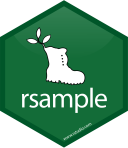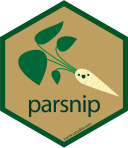4 - Evaluating models
Machine learning with tidymodels
Metrics for model performance ![]()
- RMSE: difference between the predicted and observed values ⬇️
- \(R^2\): squared correlation between the predicted and observed values ⬆️
- MAE: similar to RMSE, but mean absolute error ⬇️
Metrics for model performance ![]()
Metrics for model performance ![]()
Metrics for model performance ![]()
We’ll talk about classification metrics tomorrow!
⚠️ DANGERS OF OVERFITTING ⚠️
Dangers of overfitting ⚠️

Dangers of overfitting ⚠️

Dangers of overfitting ⚠️ ![]()
tree_fit %>%
augment(frog_train)
#> # A tibble: 456 × 6
#> treatment reflex age t_o_d latency .pred
#> <chr> <fct> <dbl> <fct> <dbl> <dbl>
#> 1 control full 5.42 morning 33 39.8
#> 2 control full 5.38 morning 19 66.7
#> 3 control full 5.38 morning 2 66.7
#> 4 control full 5.44 morning 39 39.8
#> 5 control full 5.41 morning 42 39.8
#> 6 control full 4.75 afternoon 20 59.8
#> 7 control full 4.95 night 31 83.1
#> 8 control full 5.42 morning 21 39.8
#> 9 gentamicin full 5.39 morning 30 64.6
#> 10 control full 4.55 afternoon 43 174.
#> # … with 446 more rows
#> # ℹ Use `print(n = ...)` to see more rowsWe call this “resubstitution” or “repredicting the training set”
Dangers of overfitting ⚠️ ![]()
We call this a “resubstitution estimate”
Dangers of overfitting ⚠️ ![]()
Dangers of overfitting ⚠️ ![]()
⚠️ Remember that we’re demonstrating overfitting
⚠️ Don’t use the test set until the end of your modeling analysis
Your turn

Use augment() and metrics() to compute a regression metric like mae().
Compute the metrics for both training and testing data.
Notice the evidence of overfitting! ⚠️
05:00
Dangers of overfitting ⚠️ ![]()
What if we want to compare more models?
And/or more model configurations?
And we want to understand if these are important differences?
The testing data are precious 💎
How can we use the training data to compare and evaluate different models? 🤔
Cross-validation
Cross-validation
Your turn

If we use 10 folds, what percent of the training data
- ends up in analysis
- ends up in assessment
for each fold?

03:00
Cross-validation ![]()
vfold_cv(frog_train) # v = 10 is default
#> # 10-fold cross-validation
#> # A tibble: 10 × 2
#> splits id
#> <list> <chr>
#> 1 <split [410/46]> Fold01
#> 2 <split [410/46]> Fold02
#> 3 <split [410/46]> Fold03
#> 4 <split [410/46]> Fold04
#> 5 <split [410/46]> Fold05
#> 6 <split [410/46]> Fold06
#> 7 <split [411/45]> Fold07
#> 8 <split [411/45]> Fold08
#> 9 <split [411/45]> Fold09
#> 10 <split [411/45]> Fold10Cross-validation ![]()
What is in this?
Cross-validation ![]()
Cross-validation ![]()
vfold_cv(frog_train, strata = latency)
#> # 10-fold cross-validation using stratification
#> # A tibble: 10 × 2
#> splits id
#> <list> <chr>
#> 1 <split [408/48]> Fold01
#> 2 <split [408/48]> Fold02
#> 3 <split [408/48]> Fold03
#> 4 <split [409/47]> Fold04
#> 5 <split [411/45]> Fold05
#> 6 <split [412/44]> Fold06
#> 7 <split [412/44]> Fold07
#> 8 <split [412/44]> Fold08
#> 9 <split [412/44]> Fold09
#> 10 <split [412/44]> Fold10Stratification often helps, with very little downside
Cross-validation ![]()
We’ll use this setup:
set.seed(123)
frog_folds <- vfold_cv(frog_train, v = 10, strata = latency)
frog_folds
#> # 10-fold cross-validation using stratification
#> # A tibble: 10 × 2
#> splits id
#> <list> <chr>
#> 1 <split [408/48]> Fold01
#> 2 <split [408/48]> Fold02
#> 3 <split [408/48]> Fold03
#> 4 <split [409/47]> Fold04
#> 5 <split [411/45]> Fold05
#> 6 <split [412/44]> Fold06
#> 7 <split [412/44]> Fold07
#> 8 <split [412/44]> Fold08
#> 9 <split [412/44]> Fold09
#> 10 <split [412/44]> Fold10Set the seed when creating resamples
We are equipped with metrics and resamples!
Fit our model to the resamples
tree_res <- fit_resamples(tree_wflow, frog_folds)
tree_res
#> # Resampling results
#> # 10-fold cross-validation using stratification
#> # A tibble: 10 × 4
#> splits id .metrics .notes
#> <list> <chr> <list> <list>
#> 1 <split [408/48]> Fold01 <tibble [2 × 4]> <tibble [0 × 3]>
#> 2 <split [408/48]> Fold02 <tibble [2 × 4]> <tibble [0 × 3]>
#> 3 <split [408/48]> Fold03 <tibble [2 × 4]> <tibble [0 × 3]>
#> 4 <split [409/47]> Fold04 <tibble [2 × 4]> <tibble [0 × 3]>
#> 5 <split [411/45]> Fold05 <tibble [2 × 4]> <tibble [0 × 3]>
#> 6 <split [412/44]> Fold06 <tibble [2 × 4]> <tibble [0 × 3]>
#> 7 <split [412/44]> Fold07 <tibble [2 × 4]> <tibble [0 × 3]>
#> 8 <split [412/44]> Fold08 <tibble [2 × 4]> <tibble [0 × 3]>
#> 9 <split [412/44]> Fold09 <tibble [2 × 4]> <tibble [0 × 3]>
#> 10 <split [412/44]> Fold10 <tibble [2 × 4]> <tibble [0 × 3]>Evaluating model performance ![]()
We can reliably measure performance using only the training data 🎉
Comparing metrics ![]()
How do the metrics from resampling compare to the metrics from training and testing?
The RMSE previously was
- 49.36 for the training set
- 59.16 for test set
Remember that:
⚠️ the training set gives you overly optimistic metrics
⚠️ the test set is precious
Evaluating model performance ![]()
# Save the assessment set results
ctrl_frog <- control_resamples(save_pred = TRUE)
tree_res <- fit_resamples(tree_wflow, frog_folds, control = ctrl_frog)
tree_preds <- collect_predictions(tree_res)
tree_preds
#> # A tibble: 456 × 5
#> id .pred .row latency .config
#> <chr> <dbl> <int> <dbl> <chr>
#> 1 Fold01 39.6 1 33 Preprocessor1_Model1
#> 2 Fold01 72.1 3 2 Preprocessor1_Model1
#> 3 Fold01 63.8 9 30 Preprocessor1_Model1
#> 4 Fold01 72.1 13 46 Preprocessor1_Model1
#> 5 Fold01 43.3 28 11 Preprocessor1_Model1
#> 6 Fold01 61.7 35 41 Preprocessor1_Model1
#> 7 Fold01 39.6 51 43 Preprocessor1_Model1
#> 8 Fold01 134. 70 20 Preprocessor1_Model1
#> 9 Fold01 70.6 74 21 Preprocessor1_Model1
#> 10 Fold01 39.6 106 14 Preprocessor1_Model1
#> # … with 446 more rows
#> # ℹ Use `print(n = ...)` to see more rowsWhere are the fitted models? ![]()
tree_res
#> # Resampling results
#> # 10-fold cross-validation using stratification
#> # A tibble: 10 × 5
#> splits id .metrics .notes .predictions
#> <list> <chr> <list> <list> <list>
#> 1 <split [408/48]> Fold01 <tibble [2 × 4]> <tibble [0 × 3]> <tibble [48 × 4]>
#> 2 <split [408/48]> Fold02 <tibble [2 × 4]> <tibble [0 × 3]> <tibble [48 × 4]>
#> 3 <split [408/48]> Fold03 <tibble [2 × 4]> <tibble [0 × 3]> <tibble [48 × 4]>
#> 4 <split [409/47]> Fold04 <tibble [2 × 4]> <tibble [0 × 3]> <tibble [47 × 4]>
#> 5 <split [411/45]> Fold05 <tibble [2 × 4]> <tibble [0 × 3]> <tibble [45 × 4]>
#> 6 <split [412/44]> Fold06 <tibble [2 × 4]> <tibble [0 × 3]> <tibble [44 × 4]>
#> 7 <split [412/44]> Fold07 <tibble [2 × 4]> <tibble [0 × 3]> <tibble [44 × 4]>
#> 8 <split [412/44]> Fold08 <tibble [2 × 4]> <tibble [0 × 3]> <tibble [44 × 4]>
#> 9 <split [412/44]> Fold09 <tibble [2 × 4]> <tibble [0 × 3]> <tibble [44 × 4]>
#> 10 <split [412/44]> Fold10 <tibble [2 × 4]> <tibble [0 × 3]> <tibble [44 × 4]>🗑️
Alternate resampling schemes
Bootstrapping
Bootstrapping ![]()
set.seed(3214)
bootstraps(frog_train)
#> # Bootstrap sampling
#> # A tibble: 25 × 2
#> splits id
#> <list> <chr>
#> 1 <split [456/163]> Bootstrap01
#> 2 <split [456/166]> Bootstrap02
#> 3 <split [456/173]> Bootstrap03
#> 4 <split [456/177]> Bootstrap04
#> 5 <split [456/166]> Bootstrap05
#> 6 <split [456/163]> Bootstrap06
#> 7 <split [456/164]> Bootstrap07
#> 8 <split [456/165]> Bootstrap08
#> 9 <split [456/170]> Bootstrap09
#> 10 <split [456/177]> Bootstrap10
#> # … with 15 more rows
#> # ℹ Use `print(n = ...)` to see more rowsYour turn

Create:
- bootstrap folds (change
timesfrom the default) - validation set (use the reference guide to find the function)
Don’t forget to set a seed when you resample!
05:00
Bootstrapping ![]()
set.seed(322)
bootstraps(frog_train, times = 10)
#> # Bootstrap sampling
#> # A tibble: 10 × 2
#> splits id
#> <list> <chr>
#> 1 <split [456/173]> Bootstrap01
#> 2 <split [456/168]> Bootstrap02
#> 3 <split [456/170]> Bootstrap03
#> 4 <split [456/164]> Bootstrap04
#> 5 <split [456/176]> Bootstrap05
#> 6 <split [456/156]> Bootstrap06
#> 7 <split [456/166]> Bootstrap07
#> 8 <split [456/168]> Bootstrap08
#> 9 <split [456/167]> Bootstrap09
#> 10 <split [456/170]> Bootstrap10Validation set ![]()
A validation set is just another type of resample
Decision tree 🌳
Random forest 🌳🌲🌴🌵🌴🌳🌳🌴🌲🌵🌴🌲🌳🌴🌳🌵🌵🌴🌲🌲🌳🌴🌳🌴🌲🌴🌵🌴🌲🌴🌵🌲🌵🌴🌲🌳🌴🌵🌳🌴🌳
Random forest 🌳🌲🌴🌵🌳🌳🌴🌲🌵🌴🌳🌵
Ensemble many decision tree models
All the trees vote! 🗳️
Bootstrap aggregating + random predictor sampling
- Often works well without tuning hyperparameters (more on this tomorrow!), as long as there are enough trees
Create a random forest model ![]()
Create a random forest model ![]()
rf_wflow <- workflow(latency ~ ., rf_spec)
rf_wflow
#> ══ Workflow ══════════════════════════════════════════════════════════
#> Preprocessor: Formula
#> Model: rand_forest()
#>
#> ── Preprocessor ──────────────────────────────────────────────────────
#> latency ~ .
#>
#> ── Model ─────────────────────────────────────────────────────────────
#> Random Forest Model Specification (regression)
#>
#> Main Arguments:
#> trees = 1000
#>
#> Computational engine: rangerYour turn

Use fit_resamples() and rf_wflow to:
- keep predictions
- compute metrics
- plot true vs. predicted values
08:00
Evaluating model performance ![]()
ctrl_frog <- control_resamples(save_pred = TRUE)
# Random forest uses random numbers so set the seed first
set.seed(2)
rf_res <- fit_resamples(rf_wflow, frog_folds, control = ctrl_frog)
collect_metrics(rf_res)
#> # A tibble: 2 × 6
#> .metric .estimator mean n std_err .config
#> <chr> <chr> <dbl> <int> <dbl> <chr>
#> 1 rmse standard 55.9 10 1.71 Preprocessor1_Model1
#> 2 rsq standard 0.370 10 0.0306 Preprocessor1_Model1How can we compare multiple model workflows at once?
Evaluate a workflow set
Evaluate a workflow set
workflow_set(list(latency ~ .), list(tree_spec, rf_spec)) %>%
workflow_map("fit_resamples", resamples = frog_folds)
#> # A workflow set/tibble: 2 × 4
#> wflow_id info option result
#> <chr> <list> <list> <list>
#> 1 formula_decision_tree <tibble [1 × 4]> <opts[1]> <rsmp[+]>
#> 2 formula_rand_forest <tibble [1 × 4]> <opts[1]> <rsmp[+]>Evaluate a workflow set
workflow_set(list(latency ~ .), list(tree_spec, rf_spec)) %>%
workflow_map("fit_resamples", resamples = frog_folds) %>%
rank_results()
#> # A tibble: 4 × 9
#> wflow_id .config .metric mean std_err n prepr…¹ model rank
#> <chr> <chr> <chr> <dbl> <dbl> <int> <chr> <chr> <int>
#> 1 formula_rand_forest Prepro… rmse 55.8 1.71 10 formula rand… 1
#> 2 formula_rand_forest Prepro… rsq 0.371 0.0301 10 formula rand… 1
#> 3 formula_decision_tree Prepro… rmse 59.6 2.31 10 formula deci… 2
#> 4 formula_decision_tree Prepro… rsq 0.305 0.0342 10 formula deci… 2
#> # … with abbreviated variable name ¹preprocessorThe first metric of the metric set is used for ranking. Use rank_metric to change that.
Lots more available with workflow sets, like collect_metrics(), autoplot() methods, and more!
Your turn

When do you think a workflow set would be useful?
03:00
The final fit ![]()
Suppose that we are happy with our random forest model.
Let’s fit the model on the training set and verify our performance using the test set.
We’ve shown you fit() and predict() (+ augment()) but there is a shortcut:
# frog_split has train + test info
final_fit <- last_fit(rf_wflow, frog_split)
final_fit
#> # Resampling results
#> # Manual resampling
#> # A tibble: 1 × 6
#> splits id .metrics .notes .predictions .workflow
#> <list> <chr> <list> <list> <list> <list>
#> 1 <split [456/116]> train/test split <tibble> <tibble> <tibble> <workflow>What is in final_fit? ![]()
These are metrics computed with the test set
What is in final_fit? ![]()
collect_predictions(final_fit)
#> # A tibble: 116 × 5
#> id .pred .row latency .config
#> <chr> <dbl> <int> <dbl> <chr>
#> 1 train/test split 43.5 1 22 Preprocessor1_Model1
#> 2 train/test split 104. 3 106 Preprocessor1_Model1
#> 3 train/test split 76.2 6 39 Preprocessor1_Model1
#> 4 train/test split 42.4 8 50 Preprocessor1_Model1
#> 5 train/test split 43.5 10 63 Preprocessor1_Model1
#> 6 train/test split 43.1 14 25 Preprocessor1_Model1
#> 7 train/test split 51.5 16 48 Preprocessor1_Model1
#> 8 train/test split 160. 17 91 Preprocessor1_Model1
#> 9 train/test split 50.9 32 11 Preprocessor1_Model1
#> 10 train/test split 171. 33 109 Preprocessor1_Model1
#> # … with 106 more rows
#> # ℹ Use `print(n = ...)` to see more rowsThese are predictions for the test set
What is in final_fit? ![]()
extract_workflow(final_fit)
#> ══ Workflow [trained] ════════════════════════════════════════════════
#> Preprocessor: Formula
#> Model: rand_forest()
#>
#> ── Preprocessor ──────────────────────────────────────────────────────
#> latency ~ .
#>
#> ── Model ─────────────────────────────────────────────────────────────
#> Ranger result
#>
#> Call:
#> ranger::ranger(x = maybe_data_frame(x), y = y, num.trees = ~1000, num.threads = 1, verbose = FALSE, seed = sample.int(10^5, 1))
#>
#> Type: Regression
#> Number of trees: 1000
#> Sample size: 456
#> Number of independent variables: 4
#> Mtry: 2
#> Target node size: 5
#> Variable importance mode: none
#> Splitrule: variance
#> OOB prediction error (MSE): 3124.583
#> R squared (OOB): 0.3531813Use this for prediction on new data, like for deploying
Your turn

End of the day discussion!
Which model do you think you would decide to use?
What surprised you the most?
What is one thing you are looking forward to for tomorrow?
05:00
Why choose just one final_fit? ![]()
Model stacks generate predictions that are informed by several models.
Why choose just one final_fit? ![]()
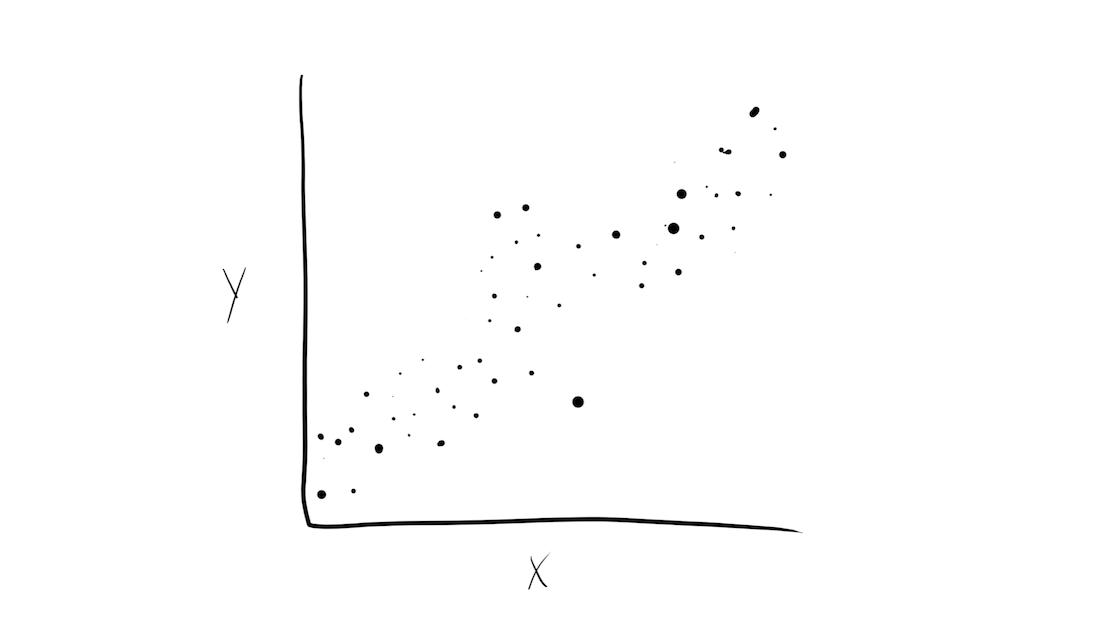
Why choose just one final_fit? ![]()
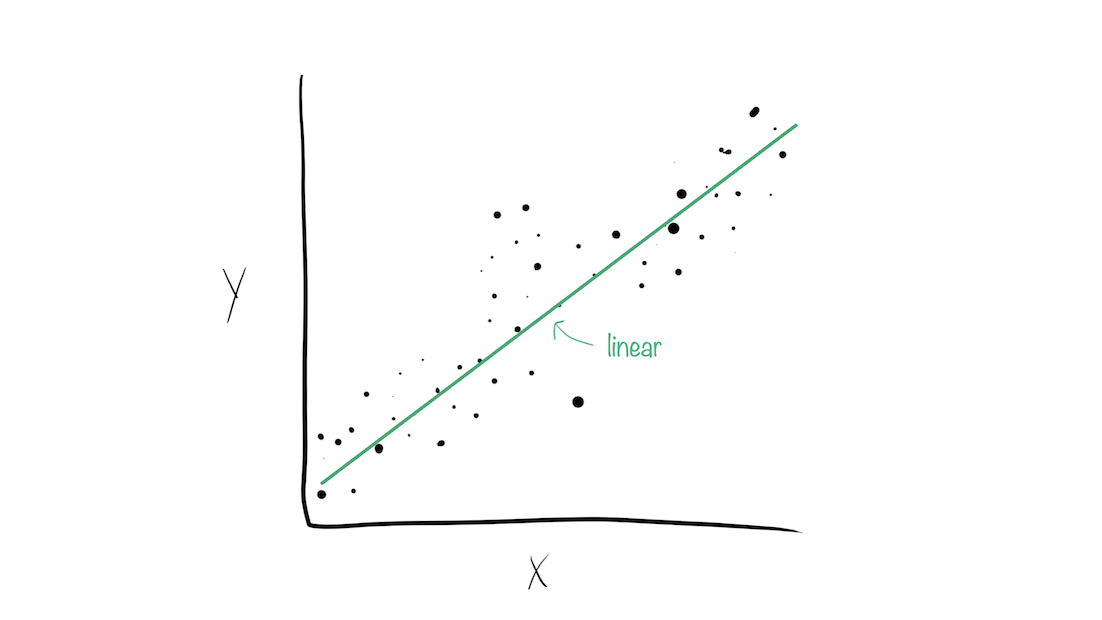
Why choose just one final_fit? ![]()
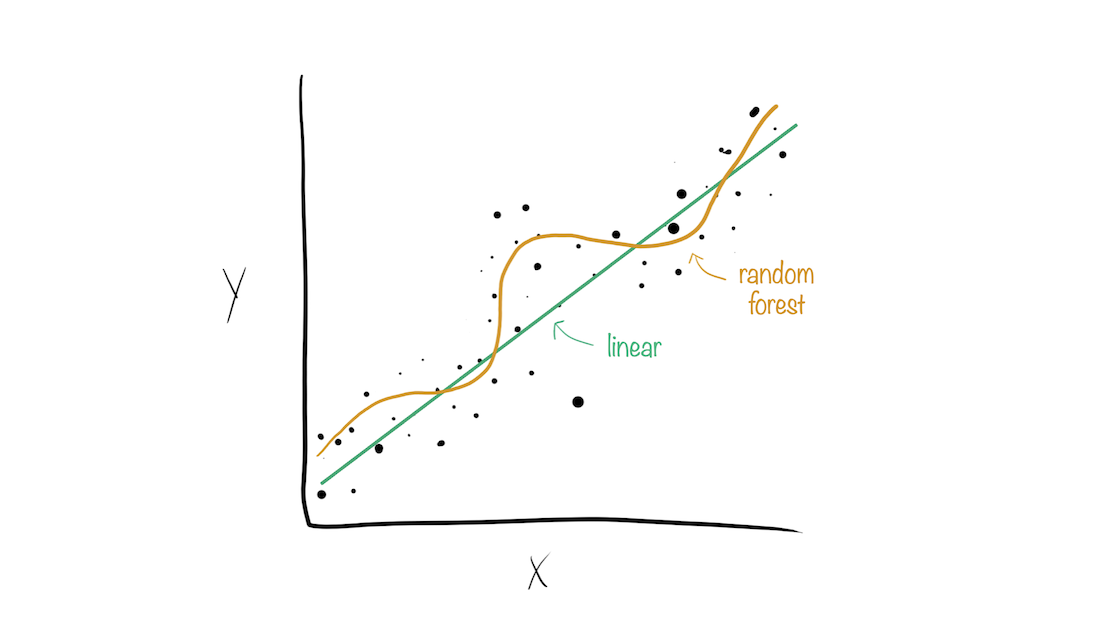
Why choose just one final_fit? ![]()
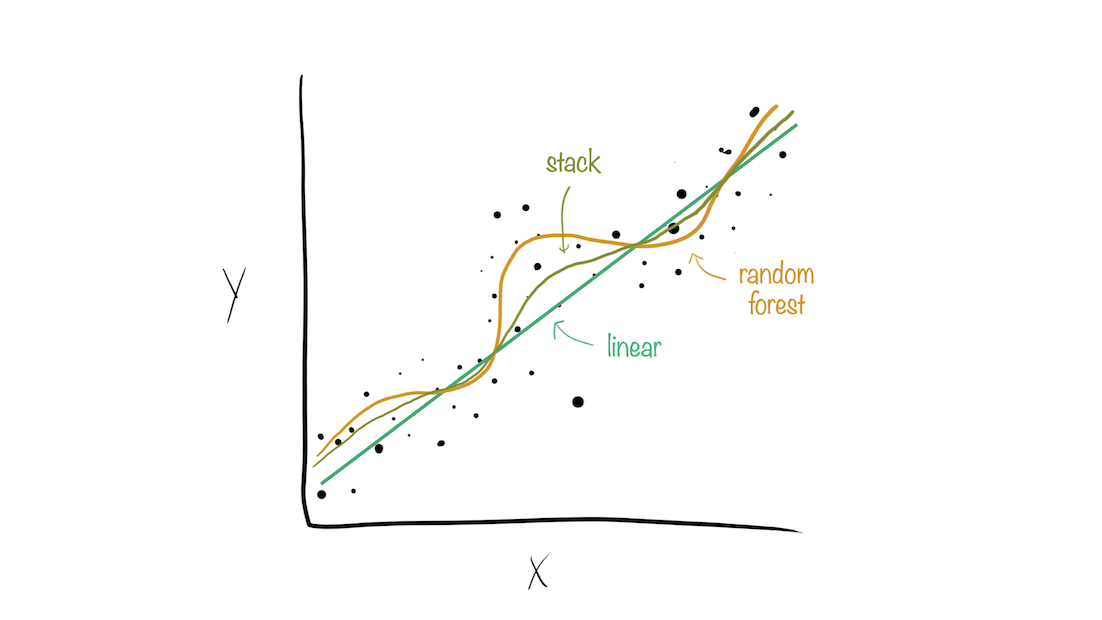
Why choose just one final_fit? ![]()
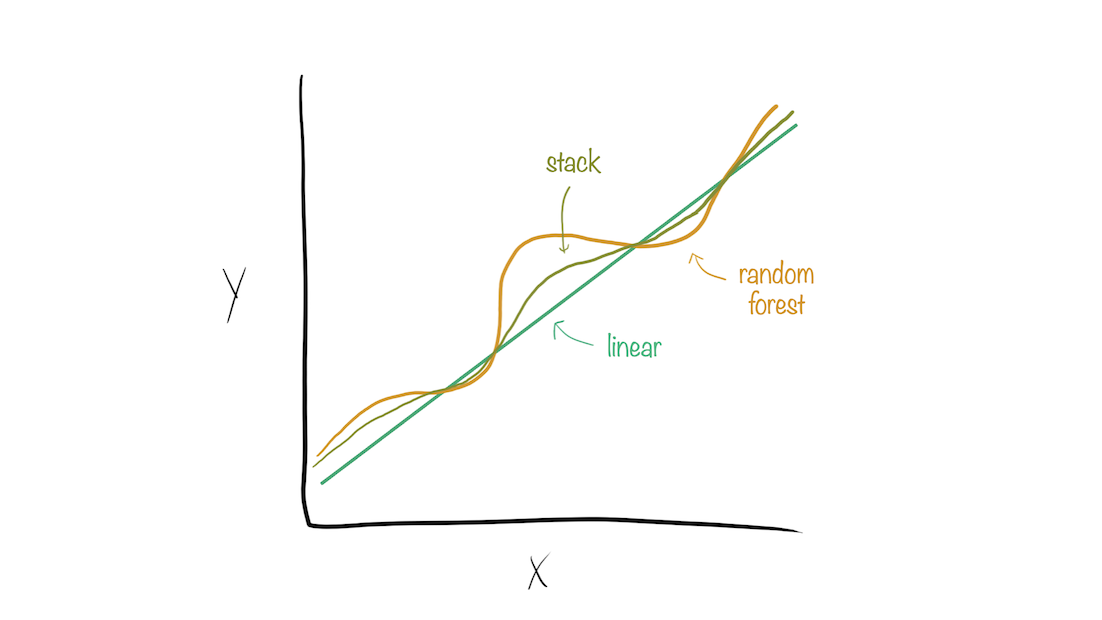
Building a model stack ![]()
- Define candidate members
- Initialize a data stack object
- Iteratively add candidate ensemble members to the data stack
- Evaluate how to combine their predictions
- Fit candidate ensemble members with non-zero stacking coefficients
- Predict on new data!
Building a model stack ![]()
Building a model stack ![]()
- Define candidate members
Start out with a linear regression:
Building a model stack ![]()
lr_res
#> # Resampling results
#> # 10-fold cross-validation using stratification
#> # A tibble: 10 × 5
#> splits id .metrics .notes .predictions
#> <list> <chr> <list> <list> <list>
#> 1 <split [408/48]> Fold01 <tibble [2 × 4]> <tibble [0 × 3]> <tibble [48 × 4]>
#> 2 <split [408/48]> Fold02 <tibble [2 × 4]> <tibble [0 × 3]> <tibble [48 × 4]>
#> 3 <split [408/48]> Fold03 <tibble [2 × 4]> <tibble [0 × 3]> <tibble [48 × 4]>
#> 4 <split [409/47]> Fold04 <tibble [2 × 4]> <tibble [0 × 3]> <tibble [47 × 4]>
#> 5 <split [411/45]> Fold05 <tibble [2 × 4]> <tibble [0 × 3]> <tibble [45 × 4]>
#> 6 <split [412/44]> Fold06 <tibble [2 × 4]> <tibble [0 × 3]> <tibble [44 × 4]>
#> 7 <split [412/44]> Fold07 <tibble [2 × 4]> <tibble [0 × 3]> <tibble [44 × 4]>
#> 8 <split [412/44]> Fold08 <tibble [2 × 4]> <tibble [0 × 3]> <tibble [44 × 4]>
#> 9 <split [412/44]> Fold09 <tibble [2 × 4]> <tibble [0 × 3]> <tibble [44 × 4]>
#> 10 <split [412/44]> Fold10 <tibble [2 × 4]> <tibble [0 × 3]> <tibble [44 × 4]>Building a model stack ![]()
Then, a random forest:
Building a model stack ![]()
rf_res
#> # Resampling results
#> # 10-fold cross-validation using stratification
#> # A tibble: 10 × 5
#> splits id .metrics .notes .predictions
#> <list> <chr> <list> <list> <list>
#> 1 <split [408/48]> Fold01 <tibble [2 × 4]> <tibble [0 × 3]> <tibble [48 × 4]>
#> 2 <split [408/48]> Fold02 <tibble [2 × 4]> <tibble [0 × 3]> <tibble [48 × 4]>
#> 3 <split [408/48]> Fold03 <tibble [2 × 4]> <tibble [0 × 3]> <tibble [48 × 4]>
#> 4 <split [409/47]> Fold04 <tibble [2 × 4]> <tibble [0 × 3]> <tibble [47 × 4]>
#> 5 <split [411/45]> Fold05 <tibble [2 × 4]> <tibble [0 × 3]> <tibble [45 × 4]>
#> 6 <split [412/44]> Fold06 <tibble [2 × 4]> <tibble [0 × 3]> <tibble [44 × 4]>
#> 7 <split [412/44]> Fold07 <tibble [2 × 4]> <tibble [0 × 3]> <tibble [44 × 4]>
#> 8 <split [412/44]> Fold08 <tibble [2 × 4]> <tibble [0 × 3]> <tibble [44 × 4]>
#> 9 <split [412/44]> Fold09 <tibble [2 × 4]> <tibble [0 × 3]> <tibble [44 × 4]>
#> 10 <split [412/44]> Fold10 <tibble [2 × 4]> <tibble [0 × 3]> <tibble [44 × 4]>Building a model stack ![]()
- Initialize a data stack object
Building a model stack ![]()
- Iteratively add candidate ensemble members to the data stack
Tomorrow we’ll discuss tuning parameters where there are different configurations of models (e.g. 10 different variations of the random forest model).
These configurations can greatly improve the performance of the stacking ensemble.
Building a model stack ![]()
- Evaluate how to combine their predictions
Building a model stack ![]()
- Fit candidate ensemble members with non-zero stacking coefficients
Building a model stack ![]()
- Predict on new data!

